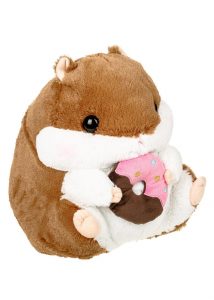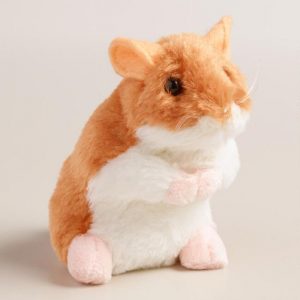Hamsters are small, compact, rat-shaped rodents. The body is short and thick, weighing 30 to 1000 grams. The length of the tail ranges from 7 to 106 mm, generally half the length of the body, without scales, overlying the hair, and a few species (such as the desert hamster) are short, less than half of the hind foot; females of certain species are larger than males. The tail hair color is quite different, generally gray, gray-brown or sandy brown. The original hamster hair color is brighter, the back is reddish brown, and the abdomen is black. Hamsters have long, thick fur. They are gray on the back, pinkish yellow, light brown or reddish brown, white, gray or black on the ventral surface. Their lateral abdomen is also often white, with some intermediate stripes and sebaceous glands.
The caries is in the form of knobs, arranged in two columns, and the left and right teeth are not opposite or nearly opposite. Hamsters have a double-chamber stomach and most do not have a gallbladder. Their large intestines and cecum are moderately complex. The number of diploid chromosomes in hamsters is between 20 and 44. There are 13 thoracic vertebrae and 6 lumbar vertebrae.
It is widely inhabited in grasslands, farmland, deserts, mountains and river valleys, farmland, gardens and orchards, and occasionally enters houses. Hamsters can be found at altitudes of up to 3,600 meters.
It mainly feeds on plant seeds, eats both plant stems and leaves, fruits, and occasionally insects. Do not hibernate. In the winter, I live by eating and storing food. In addition, some species are omnivorous and can be vertebrate such as frogs. They stuffed the food into their big cheek pockets and took them back into their caves. Up to 90 kilograms of hamster caves for storing food have been found.
Hamsters perceive visual, tactile, auditory, and chemical stimuli. When looking for prey, they seem to rely mostly on vision, but hearing and smell are also important.
Hamsters use chemicals to communicate. Males use their large sebaceous glands to mark their fields. In fact, the size of these glands is related to the individual’s position in the dominant level: the larger the gland, the greater the animal’s advantage.
As herbivores and carnivores, hamsters can be junior and intermediate consumers, and in some cases even advanced consumers, but are themselves foods for other advanced consumers. Animals that prey on hamsters include day and night raptors, snakes and mammalian carnivores.
Some varieties of hamsters feed on beans, corn, and lentils and are therefore considered harmful species.
Some breeds of hamsters have become a pet, and some have been used in laboratories for behavioral and physiological research.
Although hamsters are easy to breed and captive, some species have limited wild populations and are vulnerable to habitat destruction.
If you want to make your favorite hamster a cute stuffed animal, you can contact us, we are a OEM/ODM stuffed animal manufacturer.



